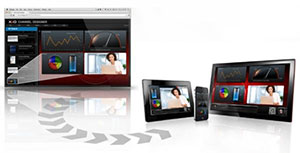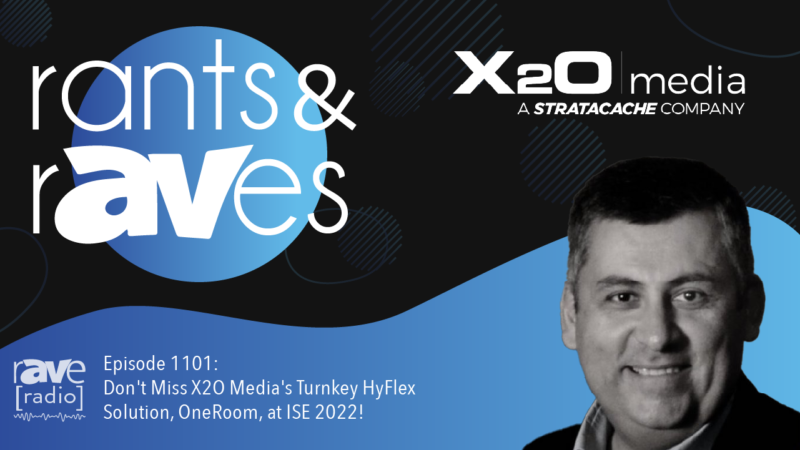Four Keys to Digital Signage Corporate Communications Success
 As corporate communications compete with the proliferation of information targeting today’s employees, connected companies are seeking new ways to engage and communicate with their workforce beyond traditional channels. Enter digital signage.
As corporate communications compete with the proliferation of information targeting today’s employees, connected companies are seeking new ways to engage and communicate with their workforce beyond traditional channels. Enter digital signage.
Connecting with Employees
Unlike emails, intranet sites, posters and pamphlets, which have saturated the business environment, digital signage proposes a new broadcast medium by engaging employees via visual-centric communications.
Furthermore, with the reliability of today’s network infrastructures, digital signage can distribute real-time information using rich, high-quality graphics and video to a variety of screens. As a result, communication professionals can focus on creating exciting digital campaigns that truly connect with their employees.
“The requirements for being successful with digital signage remain anchored in providing integrated, flexible, feature-rich content targeted to the right person, at the right time, on the right screen.” — David Wilkins is president and CEO of X2O Media
There are many digital signage applications for internal communications. These can include bolstering a company’s corporate culture via branding initiatives, conducting remote employee training, diffusing employee newsletters, displaying event programs and schedules, and communicating emergency messaging to staff. However, technologies have evolved, allowing new innovative ways to use digital signage.
Requirements for Success
- In order to be effective, solutions should now integrate seamlessly with existing systems, provide flexible publishing capabilities to reach the right users and offer functionalities that make the system both cost-effective and simple to use. What follows are four considerations essential for ensuring that your corporate communications digital signage is a success:
- A company’s primary requirement should be to ensure that a digital signage platform can successfully integrate with other internal systems. For instance, companies using Microsoft SharePoint for enterprise-wide content management could use the same content posted in SharePoint throughout their digital signage network without the need to duplicate content creation and management. Consequently, by using tight interoperability and integration, information such as KPI (Key Performance Indicator) dashboards, team calendars and company announcements could be automatically displayed without duplicating data entry, which adds to the cost of managing content.
- Second, a successful digital signage deployment should be flexible. In other words, messaging should be able to target specific divisions of an organization, particular staff members or the enterprise as a whole. By allowing local staff to customize messaging to specific screens and locations, network managers are able to better target their viewers, which increases the content’s impact, raises the probability of action from members and makes communication over the network more efficient. This can include real-time messages delivered directly to employees’ computer screens via pop-up alerts or information sent to mobile devices to reach staff members working remotely or who may be temporarily away from their desks.
- Another important consideration for digital signage platforms is the ability to leverage the HTML 5 standard, which allows content producers to create media-rich content channels that can be published easily to both onsite screens and mobile devices. This includes the capacity to distribute HD video, 3D animations, graphs and links to live data sources, which recreate TV-like experiences for viewers on any screen.
- Content creation solutions should also support the inclusion of business rules into signage workflows. This allows administrators to schedule broadcasts to coincide with optimal viewing times and better plan programming to ensure that only the most effective messaging makes it onto screens. The result is a more automated and cost-effective signage solution.
 In short, applications for corporate communications may vary, but the requirements for being successful with digital signage remain anchored in providing integrated, flexible, feature-rich content targeted to the right person, at the right time, on the right screen.
In short, applications for corporate communications may vary, but the requirements for being successful with digital signage remain anchored in providing integrated, flexible, feature-rich content targeted to the right person, at the right time, on the right screen.
David Wilkins is president and CEO of X2O Media, a provider of software for real-time visual communication applications that significantly improve enterprise-wide communications and drive business. At DSE 2013, David Wilkins delivered “Enterprise-wide Digital Signage Fundamentals,” an interactive session to help participants understand the requirements for deploying successful digital signage networks for employee communications, employee training, real-time data visualization and more.
This column was reprinted with permission from the Digital Signage Connection and originally appeared here.





